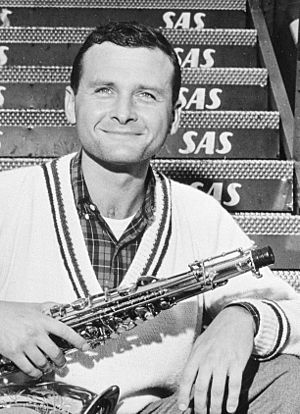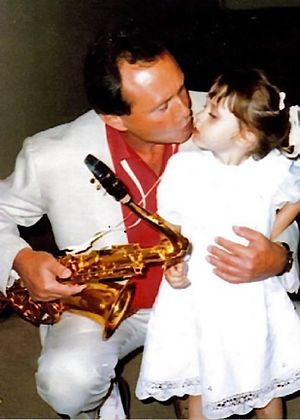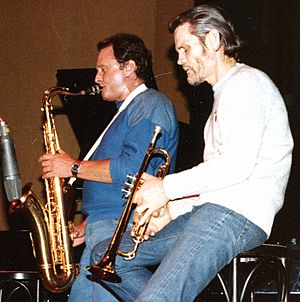Stan Getz facts for kids
Quick facts for kids
Stan Getz
|
|
|---|---|

Getz in 1958
|
|
| Background information | |
| Birth name | Stanley Getz |
| Born | February 2, 1927 Philadelphia, Pennsylvania, U.S. |
| Died | June 6, 1991 (aged 64) Malibu, California, U.S. |
| Genres |
|
| Instruments |
|
| Years active | 1943–1991 |
| Labels |
|
Stanley Getz (February 2, 1927 – June 6, 1991) was an American jazz saxophonist. Playing primarily the tenor saxophone, Getz was known as "The Sound" because of his warm, lyrical tone, with his prime influence being the wispy, mellow timbre of his idol, Lester Young. Coming to prominence in the late 1940s with Woody Herman's big band, Getz is described by critic Scott Yanow as "one of the all-time great tenor saxophonists". Getz performed in bebop and cool jazz groups. Influenced by João Gilberto and Antônio Carlos Jobim, he also helped popularize bossa nova in the United States with the hit 1964 single "The Girl from Ipanema".
Contents
Early life
Stan Getz was born on February 2, 1927, at St. Vincent's Hospital in Philadelphia, Pennsylvania, United States. Getz's father Alexander ("Al") was a Ukrainian Jewish immigrant who was born in Mile End, London, in 1904, while his mother Goldie (née Yampolsky) was born in Philadelphia in 1907. His paternal grandparents Harris and Beckie Gayetski were originally from Kyiv, Ukraine but had migrated to escape the anti-Jewish pogroms to Whitechapel, in the East End of London. While in England they owned the Harris Tailor Shop at 52 Oxford Street for more than 13 years. In 1913, Harris and Beckie emigrated to the United States with their three sons Al, Phil, and Ben, following their son Louis Gayetski who had emigrated to the US the year before. Getz's original family name, "Gayetski", was changed to Getz upon arrival in America.
The Getz family first settled in Philadelphia, but during the Great Depression the family moved to New York City, seeking better employment opportunities. Getz worked hard in school, receiving straight A's, and finished sixth grade close to the top of his class. Getz's major interest was in musical instruments and he played a number of them before his father bought him his first saxophone, a $35 alto saxophone, when he was 13. He moved on quickly to play all other saxophones, as well as the clarinet, but fell in love with the sound of the tenor saxophone, and began practicing eight hours a day. According to Getz, he only had about six months of lessons and never studied music theory or harmony.
Getz attended James Monroe High School in the Bronx. In 1941, he was accepted into the All-City High School Orchestra of New York City. This gave him a chance to receive private, free tutoring from the New York Philharmonic's Simon Kovar, a bassoon player. He also continued playing the saxophone at dances and bar mitzvahs. He eventually dropped out of school in order to pursue his musical career but was later sent back to the classroom by the school system's truancy officers.
Career
Beginnings
In 1943, at the age of 16, he joined Jack Teagarden's band and, because of his youth, he became Teagarden's ward. Getz also played along with Nat King Cole and Lionel Hampton. A period based in Los Angeles with Stan Kenton was brief. Following a comment from Kenton that his main influence, Lester Young, was too simple, he quit. After performing with Jimmy Dorsey, and Benny Goodman, Getz was a soloist with Woody Herman from 1947 to 1949 in "The Second Herd", and he first gained wide attention as one of the band's saxophonists, who were known collectively as "The Four Brothers"; the others being Serge Chaloff, Zoot Sims and Herbie Steward. With Herman, he had a hit with "Early Autumn" in 1948.
After Getz left "The Second Herd", he was able to launch his solo career. Horace Silver's trio was heard by Getz as the guest soloist at the Club Sundown in Hartford, Connecticut, in 1950, and he hired them for touring gigs, gaining Silver his earliest national exposure. For an unknown period, Silver was not paid by Getz. Silver finally left in June 1952. In the same period, Getz performed with pianists Al Haig and Duke Jordan and drummers Roy Haynes and Max Roach, as well as bassist Tommy Potter, all of whom had worked with Charlie Parker. Guitarists Jimmy Raney and Johnny Smith were also associated with the saxophonist in this period. His profile was enhanced by his featured performance on Johnny Smith's version of the song "Moonlight in Vermont", recorded in 1952, which became a hit single and stayed on the charts for months. A DownBeat readers' poll voted the single as the second best jazz record of 1952. The later album Moonlight in Vermont, reconfigured from two 10 inch LPs for a 12-inch release, was issued in 1956.
A 1953 line-up of the Dizzy Gillespie/Stan Getz Sextet featured Gillespie, Getz, Oscar Peterson, Herb Ellis, Ray Brown and Max Roach. He moved to Copenhagen, Denmark in 1958. Here he performed with pianist Jan Johansson and bassist Oscar Pettiford, among others, at the Club Montmartre.
Return to United States
Returning to the U.S. from Europe in 1961, Getz recorded the album Focus with arrangements by Eddie Sauter, who created a strings backing for the saxophonist. In a March 2021 article for the All About Jazz website, Chris May wrote of it as "one of the great masterpieces of mid-twentieth century jazz" and compared it to the work of Béla Bartók.
Getz became involved in introducing bossa nova music to the American audience. Teaming with guitarist Charlie Byrd, who had just returned from a U.S. State Department tour of Brazil, Getz recorded Jazz Samba in 1962. Getz won the Grammy for Best Jazz Performance of 1963 for his cover of Antonio Carlos Jobim's "Desafinado", from Jazz Samba. It sold over one million copies, and was awarded a gold disc. His second bossa nova album, also recorded in 1962, was Big Band Bossa Nova with composer and arranger Gary McFarland. As a follow-up, Getz recorded the album, Jazz Samba Encore!, with one of the originators of bossa nova, Brazilian guitarist Luiz Bonfá. It also sold more than a million copies by 1964, giving Getz his second gold disc.
He then recorded the album Getz/Gilberto, in 1963, with Antônio Carlos Jobim, João Gilberto and his wife, Astrud Gilberto. Their recording of "The Girl from Ipanema" won a Grammy Award. Getz/Gilberto won two Grammys (Best Album and Best Single). As a single (1964), "The Girl from Ipanema" became a smash hit. Getz and producer Creed Taylor claimed that the music's success was a result of their discovery of the talent of Astrud Gilberto, who had never before been recorded as a vocalist, shifting the spotlight away from her and depriving her of credit, when it had been her vocal rendition that had made the song a smashing success with the general public. Getz even made sure she got none of the royalties. Gilberto and later her and João Gilberto's son Marcelo disputed Getz and Taylor's version of the story.
A live album, Getz/Gilberto Vol. 2, followed, as did Getz Au Go Go (1964), a live recording at the Cafe au Go Go. While still working with the Gilbertos, he recorded the jazz album Nobody Else But Me (1964), with a new quartet including vibraphonist Gary Burton, but Verve Records, wishing to continue building the Getz brand with bossa nova, refused to release it. It came out 30 years later, after Getz had died.
Later career
In 1972, Getz recorded the jazz fusion album Captain Marvel with Chick Corea, Stanley Clarke and Tony Williams, and in this period experimented with an Echoplex on his saxophone. He had a cameo in the film The Exterminator (1980).
In the mid-1980s, Getz worked regularly in the San Francisco Bay area and taught at Stanford University as an artist-in-residence at the Stanford Jazz Workshop until 1988. In 1986, he was inducted into the DownBeat Jazz Hall of Fame. During 1988, Getz worked with Huey Lewis and the News on their Small World album. He played the extended solo on part 2 of the title track, which became a minor hit single.
His tenor saxophone of choice was the Selmer Mark VI.
Personal life

Getz married Beverly Byrne, a vocalist with the Gene Krupa band, on November 7, 1946, in Los Angeles; the couple had three children, Steve, David and Beverly.
Getz was divorced from Byrne in Mexico in 1956. Eventually, the children were awarded by the Court to Getz's second wife, Monica Silfverskiöld, daughter of Swedish physician and former Olympic medalist Nils Silfverskiöld and Swedish Countess Mary von Rosen. Monica had insisted on raising the family together, as the children had been divided among family members, and eventually, they raised five children: Steven, David, Beverley, Pamela, and Nicolaus, the last two of which were from their own marriage. The couple lived in Copenhagen, Denmark. Monica would also become Stan's manager and a major influence in his life.
In 1962, Monica returned with the family to Sweden. During the following period, as he was trying to persuade her to come back, he sent her two test pressings, one of which, Jazz Samba with Charlie Byrd, was pivotal to her plans for the next record, Getz/Gilberto.
Eventually, Monica returned from Sweden with the family. On November 21, 1962, Brazil sent scores of musicians to Carnegie Hall as a result of the bossa nova craze created by Jazz Samba. After being told by Gilberto and Jobim that Getz had been an invisible partner in their creating of the Bossa Nova by superimposing Getz's Jazz harmonies and sound on the old Samba, Monica suggested a unification of the three. Jobim and Gilberto reacted with deference and enthusiasm. Getz was reluctant, at first, as he had heard the two were "difficult." Getz had reportedly said that he was convinced, when Monica retorted, "Well, don't you have a reputation for being difficult?" They would become very close friends during the recording of Getz/Gilberto, and Gilberto would even move in with the Getzes, occasionally joined by the children of his own two marriages and his second wife, Miúcha.
Getz filed for divorce from Monica in 1981, but the couple reconciled at his insistence in 1982 and signed a Reconciliation Agreement, in which they agreed to jointly buy a house they found in San Francisco. Soon after, Monica returned to their New York home. At this time, the divorce was finalized. In 1990, Monica Getz petitioned the United States Supreme Court to have their divorce verdict overturned, although they declined. His ultimately terminal cancer was diagnosed in 1987; he died in June 1991.
Zoot Sims, who had known Getz since their time with Herman, once described him as "a nice bunch of guys", an allusion to his unpredictable personality. Bob Brookmeyer, another performing colleague, responded to speculation Getz had a heart operation with a query: “Did they put one in?”
Death
Getz died of liver cancer on June 6, 1991. His ashes were poured from his saxophone case six miles off the coast of Marina del Rey, California. In 1998, the Stan Getz Media Center and Library at Berklee College of Music was dedicated through a donation from the Herb Alpert Foundation.
Awards
- Grammy Award for Best Jazz Performance, Soloist or Small Group (Instrumental) "Desafinado", 1962
- Grammy Award for Record of the Year, "The Girl from Ipanema", 1964
- Grammy Award for Album of the Year, Getz/Gilberto, Stan Getz and João Gilberto (Verve) 1964
- Grammy Award for Best Instrumental Jazz Performance, Small Group or Soloist With Small Group, Getz/Gilberto, Stan Getz 1964
- Grammy Award for Best Jazz Solo Performance, "I Remember You", 1991
See also
 In Spanish: Stan Getz para niños
In Spanish: Stan Getz para niños


